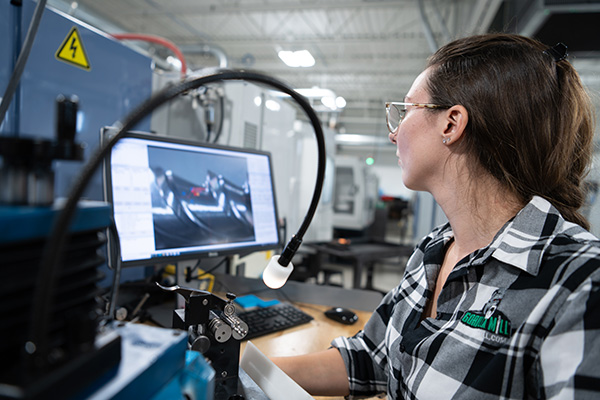A common issue in manufacturing today is new hire retention. This article discusses strategies to ensure employees remain on the payroll.
by Lisa Pustalek, Strategic Planning and Culture Development Specialist at Northwest Industrial Resource Center, part of the MEP National Network
One of the most common complaints of manufacturing human resources departments is new hire retention. It has become quite commonplace for entry-level new hires, often in their 20s, to get hired for a job, show up for work on the first day and then never be seen again. In the industry, these are called “runners.” You see them once or twice and they never come back.
The “running away” of new hires often leaves us scratching our heads and wondering why we hired them in the first place and why they behaved this way. If this is something your company has dealt with, perhaps this is a moment for introspection. Why are they running away?
The first step in solving the problem is understanding what they may be running from and what they are running to. The current manufacturing job market offers many options for people entering the workforce. Each company is doing their best to attract new hires and that means that once you hire them – another company could be trying to lure them away with enticing benefits.
Overall, new hires want to feel like they belong, and they want to know what is being asked of them and why. They want to know the big picture, not just the tasks they are being asked to perform.
The first place to start is with the onboarding process – this is where most new hires are lost. Research by the Brandon Hall Group shows that great employee onboarding can improve employee retention by 82%. Many new hires don’t stay beyond the first day, week or month, and this often has a great deal to do with the onboarding process. Start by looking at why your current employees stay. Take the time to investigate this and really discover the reasons. Then make sure you are communicating why they are staying to any new hires.
Here are some of the keys to a successful onboarding process:
It is imperative that your current management and employees learn the importance of empathy when it comes to working with new hires. Existing managers were once in their position as well and it is important to remember that. The new hire retention process is more than just educating them on human resource policies, it is also about the new employee receiving the necessary training to ensure they are doing their jobs properly and understand the process. Current employees need to know how to properly communicate with and train new hires.
People are an organization’s most valuable resource, and you want a new hire to get off on the right foot. Make sure your leaders are prepared to be role models for company culture – they are the front line of the process. They should understand the importance of treating people the way THEY would want to be treated as a brand-new employee. They should be taught to listen to what the new hires have to say and help answer any questions they may have. There can be generational differences between new hires and leaderships and those differences equate to differences in attitude and work ethic. Newcomers may not have ever had to work a full 40-hour work week and leadership should be aware of these differences and how they can bridge the gap. The onboarding process should involve building trust and loyalty. If your leadership makes a positive impression on the first day – those new hires will be excited to come back to work.

The first day should be all about setting expectations and establishing connections. New employees should feel welcome right away. Beyond a tour of the facility and employee introductions, they should see the big picture, make them understand why they are so valuable to the company and how they can make a difference. The process is much more than just showing them how to operate a machine. Some things to do on the first day include:
The critical first week is all about the organization’s big picture. After the first week the new hire should: understand the organization, begin their technical training, and visualize paths to a long-term career with the company.
This is where new employees should see how the entire organization operates. They need to get a glimpse of the inner workings of the purchasing department and see how products get packed and distributed. Take them through the accounting department so they can understand that process as well.
When they get to the technical training part, be sure that their trainer is knowledgeable, a good teacher and empathetic. Just because an employee knows how to operate a machine, does not mean that they are an effective trainer. Everyone learns differently so be sure that training involves verbal, hands-on, and visual tools.
New employees should end the first week understanding the different career paths in front of them and that they now belong to an organization that is dedicated to seeing them succeed. Encourage employees to share their success stories to new hires and share why they love coming to work every day. Give your new employees something to look forward to!
Communication is the key for the first 90 days. Don’t just train your new employee and send them on their way. Weekly follow-ups are important because this will create connections and build trust with that employee.
Some examples of effective first 90-day communication include:
If your new hire has stayed for the first 90 days – congratulations! That is an accomplishment to be celebrated. Now what?
It is important to continue making employees feel welcome, appreciated and part of the organization’s big picture. This involves building a strong company culture. This is one of the most powerful tools in employee retention. This can include company lunch and learns and company social events. Some other ways to build a strong work culture include:
Retaining new hires beyond the first day needs to be a priority for every manufacturing organization. By taking the time to make them feel welcome, educating them about the organization and why they are so important to it, and introducing them to as many people in the company as possible will go a long way in keeping the employee coming back each day – eager to help further your company’s mission.

Lisa Pustalek is a Strategic Planning and Culture Development Specialist at Northwest Industrial Resource Center, an MEP Center based in Erie, Pennsylvania. She has more than 25 years of experience working with manufacturers to grow their people and businesses. Lisa is a certified Balanced Scorecard Professional and Development Dimensions International Facilitator. She is a member of Women in Manufacturing, National Tooling and Machining Association, National Speakers Association, and Pennsylvania Business and Professional Women.
Scott Ellyson, CEO of East West Manufacturing, brings decades of global manufacturing and supply chain leadership to the conversation. In this episode, he shares practical insights on scaling operations, navigating complexity, and building resilient manufacturing networks in an increasingly connected world.